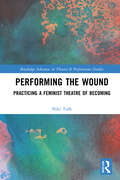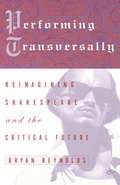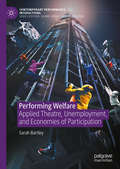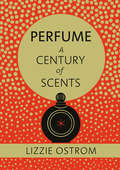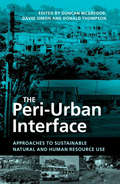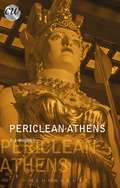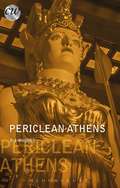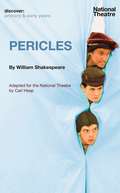- Table View
- List View
Performing the Temple of Liberty: Slavery, Theater, and Popular Culture in London and Philadelphia, 1760–1850 (Early America: History, Context, Culture)
by Jenna M. GibbsJenna M. Gibbs explores the world of theatrical and related print production on both sides of the Atlantic in an age of remarkable political and social change. Her deeply researched study of working-class and middling entertainment covers the period of the American Revolution through the first half of the nineteenth century, examining controversies over the place of black people in the Anglo-American moral imagination. Taking a transatlantic and nearly century-long view, Performing the Temple of Liberty draws on a wide range of performed texts as well as ephemera�broadsides, ballads, and cartoons�and traces changes in white racial attitudes.Gibbs asks how popular entertainment incorporated and helped define concepts of liberty, natural rights, the nature of blackness, and the evils of slavery while also generating widespread acceptance, in America and in Great Britain, of blackface performance as a form of racial ridicule. Readers follow the migration of theatrical texts, images, and performers between London and Philadelphia. The story is not flattering to either the United States or Great Britain. Gibbs's account demonstrates how British portrayals of Africans ran to the sympathetic and to a definition of liberty that produced slave manumission in 1833 yet reflected an increasingly racialized sense of cultural superiority. On the American stage, the treatment of blacks devolved into a denigrating, patronizing view embedded both in blackface burlesque and in the idea of "Liberty," the figure of the white goddess.Performing the Temple of Liberty will appeal to readers across disciplinary lines of history, literature, theater history, and culture studies. Scholars and students interested in slavery and abolition, British and American politics and culture, and Atlantic history will also take an interest in this provocative work.
Performing the Temple of Liberty: Slavery, Theater, and Popular Culture in London and Philadelphia, 1760–1850 (Early America: History, Context, Culture)
by Jenna M. GibbsJenna M. Gibbs explores the world of theatrical and related print production on both sides of the Atlantic in an age of remarkable political and social change. Her deeply researched study of working-class and middling entertainment covers the period of the American Revolution through the first half of the nineteenth century, examining controversies over the place of black people in the Anglo-American moral imagination. Taking a transatlantic and nearly century-long view, Performing the Temple of Liberty draws on a wide range of performed texts as well as ephemera—broadsides, ballads, and cartoons—and traces changes in white racial attitudes.Gibbs asks how popular entertainment incorporated and helped define concepts of liberty, natural rights, the nature of blackness, and the evils of slavery while also generating widespread acceptance, in America and in Great Britain, of blackface performance as a form of racial ridicule. Readers follow the migration of theatrical texts, images, and performers between London and Philadelphia. The story is not flattering to either the United States or Great Britain. Gibbs's account demonstrates how British portrayals of Africans ran to the sympathetic and to a definition of liberty that produced slave manumission in 1833 yet reflected an increasingly racialized sense of cultural superiority. On the American stage, the treatment of blacks devolved into a denigrating, patronizing view embedded both in blackface burlesque and in the idea of "Liberty," the figure of the white goddess.Performing the Temple of Liberty will appeal to readers across disciplinary lines of history, literature, theater history, and culture studies. Scholars and students interested in slavery and abolition, British and American politics and culture, and Atlantic history will also take an interest in this provocative work.
Performing the testimonial: Rethinking verbatim dramaturgies (Theatre: Theory – Practice – Performance)
by Amanda Stuart FisherProviding one of the first critically sustained engagements with the new forms of verbatim and testimonial theatre that emerged in the late 1990s and early 2000s, this book examines what distinguishes verbatim theatre from the more established documentary theatre traditions developed initially by Peter Weiss, Bertolt Brecht and Erwin Piscator. Examining a wide range of verbatim and testimonial plays from around the world, this book looks beyond the discourses of the real that have tended to dominate scholarship in this area and instead argues that this kind of theatre engages in acts of truth telling. Through its analysis of a range of international plays from UK, Germany, America, Australia and South Africa, the book explores theatre’s dramaturgical interrogation of testimony and how the act of witnessing itself is reconfigured when relocated outside of the psychoanalytic frame and positioned as contributing to a decolonisation of testimony.
Performing the testimonial: Rethinking verbatim dramaturgies (Theatre: Theory – Practice – Performance)
by Amanda Stuart FisherProviding one of the first critically sustained engagements with the new forms of verbatim and testimonial theatre that emerged in the late 1990s and early 2000s, this book examines what distinguishes verbatim theatre from the more established documentary theatre traditions developed initially by Peter Weiss, Bertolt Brecht and Erwin Piscator. Examining a wide range of verbatim and testimonial plays from around the world, this book looks beyond the discourses of the real that have tended to dominate scholarship in this area and instead argues that this kind of theatre engages in acts of truth telling. Through its analysis of a range of international plays from UK, Germany, America, Australia and South Africa, the book explores theatre’s dramaturgical interrogation of testimony and how the act of witnessing itself is reconfigured when relocated outside of the psychoanalytic frame and positioned as contributing to a decolonisation of testimony.
Performing the Transition to Democracy: Theater and Performance in 1970s Spain (ISSN)
by David Rodríguez-SolásThis book examines troupes, plays, festivals, performative practices, and audiences active during the final years of the Franco dictatorship and the beginning of the transition to democracy.This period, spanning 1968 to 1982, is considered the historical moment that most directly shaped contemporary Spanish politics and society. The dominant narrative of the Transition has long portrayed it as a normalized, non-confrontational, and consensual process steered by political elites. But the world of Spanish theater tells a very different story - one in which ordinary Spaniards played a vital role in the transition to democracy. The chapters of this book draw on censorship files, photographs, audiovisual and textual material, and the author’s own interviews with more than a dozen audience and troupe members. Using these sources, David Rodriguez-Solas examines the notable experimentation during this period with theatrical performance and music; the establishment of performing spaces and festivals; the development of touring networks as a way to evade censorship; and the creation of networks of support that opposed diverse forms of violence and repression.This study will be of great interest to students and scholars interested in theater and the cultural and political history of Spain in the 1960s and 1970s.
Performing the Transition to Democracy: Theater and Performance in 1970s Spain (ISSN)
by David Rodríguez-SolásThis book examines troupes, plays, festivals, performative practices, and audiences active during the final years of the Franco dictatorship and the beginning of the transition to democracy.This period, spanning 1968 to 1982, is considered the historical moment that most directly shaped contemporary Spanish politics and society. The dominant narrative of the Transition has long portrayed it as a normalized, non-confrontational, and consensual process steered by political elites. But the world of Spanish theater tells a very different story - one in which ordinary Spaniards played a vital role in the transition to democracy. The chapters of this book draw on censorship files, photographs, audiovisual and textual material, and the author’s own interviews with more than a dozen audience and troupe members. Using these sources, David Rodriguez-Solas examines the notable experimentation during this period with theatrical performance and music; the establishment of performing spaces and festivals; the development of touring networks as a way to evade censorship; and the creation of networks of support that opposed diverse forms of violence and repression.This study will be of great interest to students and scholars interested in theater and the cultural and political history of Spain in the 1960s and 1970s.
Performing the Unstageable: Success, Imagination, Failure (Engage #3)
by Karen QuigleyFrom the gouging out of eyes in Shakespeare's King Lear or Sarah Kane's Cleansed, to the adaptation of Philip Pullman's His Dark Materials trilogy, theatre has long been intrigued by the staging of challenging plays and impossible texts, images or ideas. Performing the Unstageable: Success, Imagination, Failure examines this phenomenon of what the theatre cannot do or has not been able to do at various points in its history.The book explores four principal areas to which unstageability most frequently pertains: stage directions, adaptations, violence and ghosts. Karen Quigley incorporates a wide range of case studies of both historical and contemporary theatrical productions including the Wooster Group's exploration of Hamlet via the structural frame of John Gielgud's 1964 filmed production, Elevator Repair Service's eight-hour staging of Fitzgerald's The Great Gatsby and a selection of impossible stage directions drawn from works by such playwrights as Eugene O'Neill, Philip Glass, Caryl Churchill, Sarah Kane and Alistair McDowall.Placing theatre history and performance analysis in such a context, Performing the Unstageable values what is not possible, and investigates the tricky underside of theatre's most fundamental function to bring things to the place of showing: the stage.
Performing the Unstageable: Success, Imagination, Failure (Methuen Drama Engage)
by Karen QuigleyFrom the gouging out of eyes in Shakespeare's King Lear or Sarah Kane's Blasted, to the adaptation of Philip Pullman's His Dark Materials trilogy, theatre has long been intrigued by the staging of challenging plays and impossible texts, images or ideas. Performing the Unstageable: Success, Imagination, Failure examines this phenomenon of what the theatre cannot do or has not been able to do at various points in its history.The book explores four principal areas to which unstageability most frequently pertains: stage directions, adaptations, violence and ghosts. Karen Quigley incorporates a wide range of case studies of both historical and contemporary theatrical productions including the Wooster Group's exploration of Hamlet via the structural frame of John Gielgud's 1964 filmed production, Elevator Repair Service's eight-hour staging of Fitzgerald's The Great Gatsby and a selection of impossible stage directions drawn from works by such playwrights as Eugene O'Neill, Philip Glass, Caryl Churchill, Sarah Kane and Alistair McDowall.Placing theatre history and performance analysis in such a context, Performing the Unstageable values what is not possible, and investigates the tricky underside of theatre's most fundamental function to bring things to the place of showing: the stage.
Performing the Wound: Practicing a Feminist Theatre of Becoming (Routledge Advances in Theatre & Performance Studies)
by Niki TulkThis book offers a matrixial, feminist-centered analysis of trauma and performance, through examining the work of three artists: Ann Hamilton, Renée Green, and Cecilia Vicuña. Each artist engages in a multi-media, or “combination” performance practice; this includes the use of site, embodied performance, material elements, film, and writing. Each case study involves traumatic content, including the legacy of slavery, child sexual abuse and environmental degradation; each artist constructs an aesthetic milieu that invites rather than immerses—this allows an audience to have agency, as well as multiple pathways into their engagement with the art. The author Niki Tulk suggests that these works facilitate an audience-performance relationship based on the concept of ethical witnessing/wit(h)nessing, in which viewers are not positioned as voyeurs, nor made to risk re-traumatization by being forced to view traumatic events re-played on stage. This approach also allows agency to the art itself, in that an ethical space is created where the art is not objectified or looked at—but joined with. Foundational to this investigation are the writings of Bracha L. Ettinger, Jill Bennett and Diana Taylor—particularly Ettinger’s concepts of the matrixial, carriance and border-linking. These artists and scholars present a capacity to expand and articulate answers to questions regarding how to make performance that remains compelling and truthful to the trauma experience, but not re-traumatizing. This study will be of great interest to students and scholars of performance studies, art history, visual arts, feminist studies, theatre, film, performance art, postcolonialism, rhetoric and writing.
Performing the Wound: Practicing a Feminist Theatre of Becoming (Routledge Advances in Theatre & Performance Studies)
by Niki TulkThis book offers a matrixial, feminist-centered analysis of trauma and performance, through examining the work of three artists: Ann Hamilton, Renée Green, and Cecilia Vicuña. Each artist engages in a multi-media, or “combination” performance practice; this includes the use of site, embodied performance, material elements, film, and writing. Each case study involves traumatic content, including the legacy of slavery, child sexual abuse and environmental degradation; each artist constructs an aesthetic milieu that invites rather than immerses—this allows an audience to have agency, as well as multiple pathways into their engagement with the art. The author Niki Tulk suggests that these works facilitate an audience-performance relationship based on the concept of ethical witnessing/wit(h)nessing, in which viewers are not positioned as voyeurs, nor made to risk re-traumatization by being forced to view traumatic events re-played on stage. This approach also allows agency to the art itself, in that an ethical space is created where the art is not objectified or looked at—but joined with. Foundational to this investigation are the writings of Bracha L. Ettinger, Jill Bennett and Diana Taylor—particularly Ettinger’s concepts of the matrixial, carriance and border-linking. These artists and scholars present a capacity to expand and articulate answers to questions regarding how to make performance that remains compelling and truthful to the trauma experience, but not re-traumatizing. This study will be of great interest to students and scholars of performance studies, art history, visual arts, feminist studies, theatre, film, performance art, postcolonialism, rhetoric and writing.
Performing Transversally: Reimagining Shakespeare and the Critical Future
by Bryan ReynoldsPerforming Transversally expands on Bryan Reynolds' controversial transversal theory in exciting ways while offering groundbreaking analyses of Shakespeare's plays - Hamlet , Othello , Macbeth , Taming of the Shrew , Titus Andronicus , Henry V , The Tempest , and Coriolanus - and textual, filmic, and theatrical adaptations of them. With his collaborators, Reynolds challenges traditional readings of Shakespeare, re-evaluating the critical methodologies that characterize them, in regard to issues of cultural difference, authorship, representation, agency, and iconography. Reynolds demonstrates the value of his 'investigative-expansive mode,' outlining a 'transversal poetics' that points toward a critical future that is more aware of its subjective interconnectedness with the topics and audiences it seeks to engage than is reflected in most Shakespeare criticism and literary-cultural scholarship.
Performing Truth: Works of Radical Memory for Times of Social Amnesia
by L.M. BogadPerforming Truth answers the most pressing questions facing any theatre-makers who are wrestling with how to present historical, political or socioeconomic information in an engaging, entertaining, and galvanizing way. How to make data compelling and documents mobilizing? How to keep an audience interested in what might be dry, dire, or depressing? How to surprise an audience and keep them alert? Collecting together the performance texts of international performance artist and activist L.M. Bogad, this book accompanies each script with essays that further explore that work's performance strategies. It also equips readers with specific resources and pedagogical tools to help those wishing to stage these pieces or create their own work to engage with similar topics. Bogad also provides "takeaways" for each piece, illustrating the challenges of its particular subject matter and how to overcome those challenges with innovations unique to performance art. This is a key guidebook for artists and theatre-makers facing the challenges of engaging with information in an era of fake news, propaganda bots, and the polarization of ideological spheres, as well as students and teachers taking on that challenge in theatre studies, performance studies and performing arts classrooms.
Performing Truth: Works of Radical Memory for Times of Social Amnesia
by L.M. BogadPerforming Truth answers the most pressing questions facing any theatre-makers who are wrestling with how to present historical, political or socioeconomic information in an engaging, entertaining, and galvanizing way. How to make data compelling and documents mobilizing? How to keep an audience interested in what might be dry, dire, or depressing? How to surprise an audience and keep them alert? Collecting together the performance texts of international performance artist and activist L.M. Bogad, this book accompanies each script with essays that further explore that work's performance strategies. It also equips readers with specific resources and pedagogical tools to help those wishing to stage these pieces or create their own work to engage with similar topics. Bogad also provides "takeaways" for each piece, illustrating the challenges of its particular subject matter and how to overcome those challenges with innovations unique to performance art. This is a key guidebook for artists and theatre-makers facing the challenges of engaging with information in an era of fake news, propaganda bots, and the polarization of ideological spheres, as well as students and teachers taking on that challenge in theatre studies, performance studies and performing arts classrooms.
Performing Unification: History and Nation in German Theater after 1989
by Matt CornishSince the moment after the fall of the Berlin Wall, important German theater artists have created plays and productions about unification. Some have challenged how German history is written, while others opposed the very act of storytelling. Performing Unification examines how directors, playwrights, and theater groups including Heiner Müller, Frank Castorf, and Rimini Protokoll have represented and misrepresented the past, confronting their nation’s history and collective identity. Matt Cornish surveys German-language history plays from the Baroque period through the documentary theater movement of the 1960s to show how German identity has always been contested, then turns to performances of unification after 1989. Cornish argues that theater, in its structures and its live gestures, on pages, stages, and streets, helps us to understand the past and its effect on us, our relationships with others in our communities, and our futures. Engaging with theater theory from Aristotle through Bertolt Brecht and Hans-Thies Lehmann’s “postdramatic” theater, and with theories of history from Hegel to Walter Benjamin and Hayden White, Performing Unification demonstrates that historiography and dramaturgy are intertwined.
Performing Welfare: Applied Theatre, Unemployment, and Economies of Participation (Contemporary Performance InterActions)
by Sarah BartleyThis book explores what happens to socially committed performance when state systems of social security are dismantled. Since 2010, a punishing programme of economic austerity and a seismic overhaul of the Welfare State in the United Kingdom has been accompanied by an ideological assault on dependency; a pervasive scapegoating of the poor, young, and disabled; and an intensification of the discursive relationship between morality and work. This book considers the artistic, material, and ideological consequences of such shifts for applied and socially engaged performance. Performing Welfare reveals how such arts practices might reconstitute notions of work and labour in socially constructive ways. It focuses on the political potential of participation during a period in which classifications of labour and productivity are intensely contested. It examines the migration of discourses from state policy to the cultural sector; narratives of community and aesthetics of dependency; the paradoxes of visibility in creative projects with stigmatised participants; the implicit relationship of participatory performance to neoliberal productivity; and, the parallels between gendered divisions of labour, social reproduction, and applied performance. It will appeal to students, scholars, and practitioners interested in applied and socially engaged performance, participation, community, representation, the welfare state, social policy, labour, and unemployment.
Performing Women: Stand-ups, Strumpets and Itinerants
by Alison OddeyAlison Oddey's interviews with prominent performing women span generations, cultures, perspectives, practice and the best part of the twentieth century, telling various stories collectively. Stand-ups, 'classic' actresses, film and television personalities, experimental and 'alternative' practitioners discuss why they want to perform, what motivates them, and how their personal history has contributed to their desires to perform. Oddey's critical introductory and concluding chapters analyse both historical and cultural contexts and explore themes arising from interviews. These include sense of identity, acting as playing (recapturing and revisiting childhood), displacement of roots, performing, motherhood and 'being', performing comedy, differences between theatre, film and television performance, attitudes towards and relationships with audiences, and working with directors. The prominent subtext of motherhood reveals a consciousness of split subjectivities with and beyond performance.
Performing Women: Stand-Ups, Strumpets and Itinerants
by Alison OddeyAlison Oddey's interviews with prominent performing women span generations, cultures, perspectives, practice and the best part of the twentieth-century, telling various stories collectively. Stand-ups, 'classic' actresses, film and television personalities, experimental and 'alternative' practitioners discuss why they want to perform, what motivates them, and how their personal history has contributed to their desire to perform. Oddey's critical introductory and concluding chapters analyze both historical and cultural contexts and explore themes arising from the interviews. These include sense of identity, acting as playing (recapturing and revisiting childhood), displacement of roots, performing, motherhood and 'being', performing comedy, differences between theatre, film and television performance, attitudes towards and relationships with audiences, and working with directors. The prominent subtext of motherhood reveals a consciousness of split subjectives with and beyond performance. This new edition of the book includes three new interviews with actresses, and is useful primary resource material for undergraduate students on performance studies courses.
Perfume: A Century Of Scents
by Lizzie OstromThe incredible stories of 100 perfumes from a whole century of scents. Signature scents and now lost masterpieces; the visionaries who conceived them; the wild and wonderful campaigns that launched them; the women and men who wore them – every perfume has a tale to tell. Join Lizzie Ostrom, dubbed ‘the Heston Blumenthal of perfume’ (Daily Mail), on an olfactory adventure as she explores the trends and crazes that have shaped the way we’ve spritzed.
The Peri-Urban Interface: Approaches to Sustainable Natural and Human Resource Use
by Duncan McGregor David SimonPeri-urban interfaces - the zones where urban and rural areas meet - suffer from the greatest problems to humans caused by rapid urbanization, including intense pressures on resources, slum formation, lack of adequate services such as water and sanitation, poor planning and degradation of farmland. These areas, home to hundreds of millions of people, face unique problems and need distinctive and innovative approaches and solutions. This book, authored by top researchers and practitioners, covers the full breadth and depth of the impacts of rapid urbanization on livelihoods, poverty and resources in the peri-urban zones in diverse African, Asian, Latin American and Caribbean contexts. Topics include peri-urban resource sustainability, ecosystems and societies and environmental changes in peri-urban zones. Rich case studies cover production systems and livelihoods including the impacts of irrigated vegetable production, horticulture, dairy enterprises, waste-fed fisheries and pastoral livelihoods. Also addressed are planning and development issues in the peri-urban interface including the difficulty in achieving sustainability, conflict and cooperation over resources, and a fresh look at the relationship between people and their environment. The final part of the book presents policies and strategies for promoting and measuring sustainability in peri-urban zones including community-based waste management, the co-management of watersheds and empowerment of the poor. This book is the most comprehensive examination of the challenges and solutions facing the people and environments of peri-urban zones and is essential reading for all practitioners, students and academics in geography and development.
The Peri-Urban Interface: Approaches to Sustainable Natural and Human Resource Use
by Duncan McGregor David SimonPeri-urban interfaces - the zones where urban and rural areas meet - suffer from the greatest problems to humans caused by rapid urbanization, including intense pressures on resources, slum formation, lack of adequate services such as water and sanitation, poor planning and degradation of farmland. These areas, home to hundreds of millions of people, face unique problems and need distinctive and innovative approaches and solutions. This book, authored by top researchers and practitioners, covers the full breadth and depth of the impacts of rapid urbanization on livelihoods, poverty and resources in the peri-urban zones in diverse African, Asian, Latin American and Caribbean contexts. Topics include peri-urban resource sustainability, ecosystems and societies and environmental changes in peri-urban zones. Rich case studies cover production systems and livelihoods including the impacts of irrigated vegetable production, horticulture, dairy enterprises, waste-fed fisheries and pastoral livelihoods. Also addressed are planning and development issues in the peri-urban interface including the difficulty in achieving sustainability, conflict and cooperation over resources, and a fresh look at the relationship between people and their environment. The final part of the book presents policies and strategies for promoting and measuring sustainability in peri-urban zones including community-based waste management, the co-management of watersheds and empowerment of the poor. This book is the most comprehensive examination of the challenges and solutions facing the people and environments of peri-urban zones and is essential reading for all practitioners, students and academics in geography and development.
Peri-urban Landscape: The Next Challenge (River Publishers Series in Social, Urban, Economic and Environmental Sustainability)
by Jacopo Mughini Gras Letizia PaceThis book underlines the importance of establishing, in the planning and urban policies oriented towards sustainability, a relationship between the urban expansion – observed in its different forms and dynamics – and the ability of soil and landscape to support agricultural productivity and interface processes. This is the development of a specific investigation theme linked to the problem of soil degradation and peri-urban lands allows a valuable re-interpretation in the field of landscape studies. This book queries the value of the "rural" around a city, in a multidisciplinary perspective encompassing land transformations, good practices, and urban planning trends.Land transformations are at the center of analysis and discussions on the management, planning, and design of the landscape everywhere. This topic is particularly appropriate for European landscapes where land changes are often associated with the degradation of rural and natural areas. This issue represents a crucial point within the framework of the ecological transition towards a truly sustainable society and economy, as established by the European Union.This book is the result of detailed bibliographic research, of in-depth historical research on the most recent challenges and topics of greatest interest in the field of urban studies. Original landscape transformations analyses were performed, introducing also some practical cases, considered relevant contributions in spatial planning.
Peri-urban Landscape: The Next Challenge (River Publishers Series in Social, Urban, Economic and Environmental Sustainability)
by Jacopo Mughini Gras Letizia PaceThis book underlines the importance of establishing, in the planning and urban policies oriented towards sustainability, a relationship between the urban expansion – observed in its different forms and dynamics – and the ability of soil and landscape to support agricultural productivity and interface processes. This is the development of a specific investigation theme linked to the problem of soil degradation and peri-urban lands allows a valuable re-interpretation in the field of landscape studies. This book queries the value of the "rural" around a city, in a multidisciplinary perspective encompassing land transformations, good practices, and urban planning trends.Land transformations are at the center of analysis and discussions on the management, planning, and design of the landscape everywhere. This topic is particularly appropriate for European landscapes where land changes are often associated with the degradation of rural and natural areas. This issue represents a crucial point within the framework of the ecological transition towards a truly sustainable society and economy, as established by the European Union.This book is the result of detailed bibliographic research, of in-depth historical research on the most recent challenges and topics of greatest interest in the field of urban studies. Original landscape transformations analyses were performed, introducing also some practical cases, considered relevant contributions in spatial planning.
Periclean Athens (Classical World)
by P. J. RhodesIn the second and third quarters of the fifth century BC, when Athens became both politically and culturally dominant in the Greek world, Pericles was the leading figure in the city's public life. At this time Athens developed an empire of a kind which no Greek city had had before, and its politics were reshaped by the new institution of democracy.These changes inspired religious developments, while the sophists revolutionised philosophy, analysed human affairs in human terms, and Athenian tragedy became the principal Greek poetic form. This volume's illustrations further show the numerous artistic and sculptural developments in Pericles' time, as the building programmes attracted architects, builders and sculptors to Athens, and Athenian red-figure pottery reached new heights of skill in the scenes painted on it.This concise and accessible introduction guides students through the key aspects of this most-studied period of ancient Greek history, focusing on the major developments, political and cultural, that took place in Pericles' time.
Periclean Athens (Classical World)
by Pj RhodesIn the second and third quarters of the fifth century BC, when Athens became both politically and culturally dominant in the Greek world, Pericles was the leading figure in the city's public life. At this time Athens developed an empire of a kind which no Greek city had had before, and its politics were reshaped by the new institution of democracy.These changes inspired religious developments, while the sophists revolutionised philosophy, analysed human affairs in human terms, and Athenian tragedy became the principal Greek poetic form. This volume's illustrations further show the numerous artistic and sculptural developments in Pericles' time, as the building programmes attracted architects, builders and sculptors to Athens, and Athenian red-figure pottery reached new heights of skill in the scenes painted on it.This concise and accessible introduction guides students through the key aspects of this most-studied period of ancient Greek history, focusing on the major developments, political and cultural, that took place in Pericles' time.
Pericles: With The Story Of The Prince Of Tyre... . (Oberon Plays for Young People)
by William Shakespeare Carl HeapAdapted for The National Theatre by Carl Heap 'The world to me is like a lasting storm' An exciting tale of shipwrecks and magic, villains and heroes, and a child's fight for survival in a foreign land. Join Pericles on his epic travels of adventure and discovery. Primary Classics, produced by the National Theatre's Discover programme, aims to introduce children aged 7 to 11 to Shakespeare. This version of Pericles, adapted and originally directed by Carl Heap, preserves the core of Shakespeare's plot, retains the original langauge, yet is presented very much with the target age group in mind. Carl Heap's introduction will help readers, teachers and practitioners alike to imagine or produce their own version.




